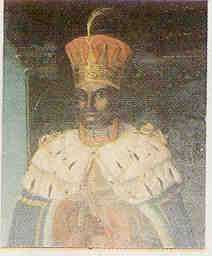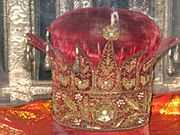Muhammad Ali Shah
| Muhammad Ali Shah | |
|---|---|
| King of Oudh | |
 | |
| | |
| Reign | 7 July 1837 – 17 May 1842 |
| Predecessor | Nasiruddin Haider |
| Successor | Amjad Ali Shah |
| Full name | |
| Abul Fateh Moinuddin Muhammad Ali Shah | |
| Father | Saadat Ali Khan II |
| Born | 1777 |
| Died | 17 May 1842 Lucknow |
| Burial | Husainabad (Chhota) Imambara, Lucknow |
| Religion | Shia Islam |
Muhammad Ali Shah (Hindi: मुहम्मद अली शाह, Urdu: محمّد علی شاہ) (Urdu:محمّد علی شاہ) (b. c. 1777 – d. 17 May 1842) was the third King of Oudh from 7 July 1837 to 17 May 1842.[1][2]
Life
Muhammad Ali Shah was son of Saadat Ali brother of Ghaziuddin Haider and uncle of Nasiruddin Haider.[2]
Succession

Nasir-ud-din Haider died without an offspring and Ghazi-ud-din Haider's queen 'Padshah Begum' put forward Munna Jan, as a claimant to the throne though both Ghazi-ud- din Haider and Nasir-ud-din Haider had refused to acknowledge him as belonging to the royal family. The begum forcibly enthroned Munna Jan at Lal Baradari. The British Raj intervened and exploited the situation to their interest. There was first battle between Oudh and British forces. They arrested both the begum and Munna Jan and arranged for the accession of late Nawab Saadat Ali Khan's son, Nasir-ud-daula, under title of 'Muhammad Ali Shah', after getting a written assurance that he will accept any new treaty put up by Governor General. He promised to pay a large sum of money to the British for this.[2][3]
Administration
Muhammad Ali Shah was 63 years of age when he ascended the throne. But he was an experienced man and had seen the glorious days of his father. He started to economise and set right the administration.[4] His administrative, financial and defence powers were reduced very much.[2]
Construction work

He built the Husainabad (Chhota) Imambara in 1838 and created Huseinabad Endowment Fund (now Husainabad Trust) to support it.[5]
He also built Husainabad Picture Gallery which is adjacent to the Clock Tower, this Gallery contains the life-size portraits of the Nawabs of Oudh.[6]
He also started to build an edifice similar to Babylon's minaret or floating garden and named it Satkhanda, but it reached only its fifth storey in 1842 when he died.[4]
Construction of great Jama Masjid situated to west of the Hussainabad Imambara was also started by him but completed after his death.[7]
Nawab Mohammad Ali Shah of Oudh also built the Shrine of Hurr at Karbala.[8]
Death
He died on 16 May 1842 AD.[9]
Timeline
| Preceded by Naser ad-Din Haydar Solayman Jah Shah |
Padshah-e-Oudh, Shah-e Zaman 7 Jul 1837 – 17 May 1842 |
Succeeded by Naser ad-Dowla Amjad 'Ali Thorayya Jah Shah |
References
- ↑ Princely States of India
- ↑ 2.0 2.1 2.2 2.3 HISTORY OF AWADH (Oudh) a princely State of India by Hameed Akhtar Siddiqui
- ↑ Nasir-ud-din Haider (1827–1873)
- ↑ 4.0 4.1 Muhammad Ali Shah (1837–1842)
- ↑ Nawabs of Oudh
- ↑ Places To See in Lucknow
- ↑ Lucknow – the city of Nawabs
- ↑ Al Mashad al Husain-Karbala: Phases of Destruction & Restoration « Muslim Unity
- ↑ History Of Lucknow
Notes
External links
- Royal line of Nawabs of Oudh
- National Informatics Centre, Lucknow – Rulers of Awadh
- NAWABS OF OUDH & THEIR SECULARISM – Dr. B. S. Saxena
- HISTORY OF AWADH (Oudh) a princely State of India by Hameed Akhtar Siddiqui